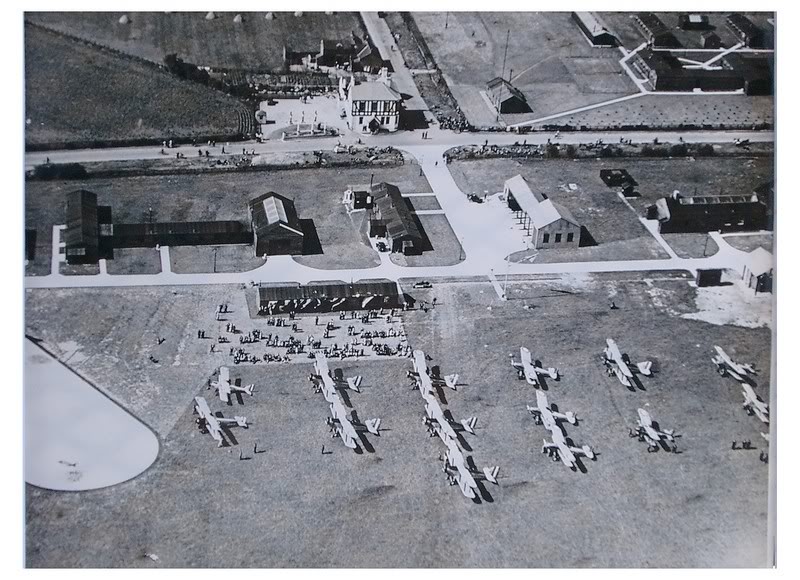

RAF Usworth (HER 1824)
Aircraft were first flown from the West Town Moor or Hylton site that would later become RAF Usworth in October 1916, when it was a station for one of the flights in No. 36 Squadron, who were located here in response to the recent Zeppelin raids on the area. For most of the 1920s, the airfield was left largely unused, although the fabric of the base was added to when the construction of a large ‘Lamella’ hanger began in 1929, based on a German design. This would appear to have been in preparation for the reactivation of the base in March 1930 as a home for the new day bomber squadron, No. 607 (County of Durham), part of the Royal Auxiliary Air Force. However, no personnel or aircraft from the squadron actually arrived until September 1932. In 1937, the regular 103 (B) Squadron moved in, although they relocated south to Abingdon in September 1939.
At the start of World War Two, Usworth was redesignated as a Sector Fighter Station under the Dowding System [see entry on Kenton Bar Bunker], and, as part of 13 Group, was placed under the control of the new Group Operations Room at the Kenton Bar bunker. In 13 Group’s most famous action, the defeat of a massive Luftwaffe raid on the north of England on August 15, 1940, Usworth played an important role. Flawed German intelligence had mistakenly identified Usworth as a major fighter base, and designated it as one of the primary targets for the raid. A massive, co-ordinated response managed to repel the raid with very little loss, and 607 Squadron (based at Usworth at the time) shot down four German Heinkel aircraft while defending their home base. This attack saw the end of large scale aerial fighting over the North East, and from then on Usworth was used mostly as a training base. From around 1943 onwards, flying from Usworth seems to have dwindled to almost nothing, partly due to the establishment of a number of barrage balloon sites nearby, which made any flying, and especially the training of inexperienced pilots, very hazardous.
Originally, Usworth had three different types of hangar, two runways, and eight dispersal points. These dispersals would each house aircraft, scattering them around the airfield, and making them less susceptible to air attack. Aircraft pens at some of the dispersal points show up on aerial photos taken in 1956, and seem to be of a classic design, in which earth was piled up in the shape of a letter E, giving two bays that would each harbour one fighter, affording them some protection against a bomb blast. The site also had substantial defences against ground attack, and was guarded by three Pickett Hamilton forts, several other pillboxes, at least one Bren gun emplacement, and a Battle HQ - an underground bunker with a concrete observation cupola attached, from where the airfield’s ground based defences would be controlled. Almost all of the airfield and its ancillary buildings have now been destroyed by recent developments, and the 1929 Lamella hanger was removed recently, leaving only two blast mounds and a Pickett Hamilton fort still intact. The North East Aircraft Museum is now housed at the site(Smith 1983 and history by D. Charles on
http://www.neam.co.uk/usworth2.html, Ripleyand Pears 1994-2006).

https://en.wikipedia.org/wiki/RAF_Usworth
http://www.forgottenairfields.com/united-kingdom/england/northumberland/usworth-s958.html
http://www.nelsam.org.uk/NEAR/Airfields/Histories/Usworth.htm
| Memories of an NCO who trained at RAF Usworth | |
|---|---|
| Colin Wise British NCO served as air gunner with 625 Sqdn, RAF in GB, 1944-1945 This is reel 1 of an oral history by Colin himself recorded by the imperial war museum. |
|
| Source: Copyright IWM | Complete interview |
| Memories of Pilot based at RAF Usworth 1941 | |
|---|---|
| Robert William Foster British officer served as pilot with 605 Sqdn, RAF in GB, 1940-1941 including Battle of Britain; served with 54 Sqdn, RAF in GB and Australia, 1942-1944 This is reel 1 of an oral history by Robert himself recorded by the imperial war museum. |
|
| Source: Copyright IWM | Complete interview |